These vegetable gyoza, Yasai gyoza, are filled with a wonderful combination of crunchy cabbage and water chestnuts, fragrant ginger and chives and salty unami miso. They are a favourite dinner, lunch or starter, and can be cooked from frozen. This recipe for gyoza is similar to my mushroom gyoza, but without mushrooms, in a bid to please some of my mushroom hating family members.

These Yaki-gyoza (pan seared gyoza) are first pan fried to get a golden bottom, before water is added to the pan and then covered to steam. Once the water has evaporated, the lid is removed allowing them to continue to get that golden base. with that crispy golden base, and soft and slightly chewy top, these potstickers are pretty addictive!
Jump to:
Why we love this recipe
- These veggie gyoza are packed with vegetables, and you can use whichever vegetables your family enjoys, such as pepper (capsicum), corn, spinach, broccoli – use your imagination! Roast or stir fry the vegetables first to remove any liquid.
- They are suitable for vegans.
- These vegetarian dumplings are loved by meat eaters too (which make them great for a family with different diets).
- They are great for batch cooking: they freeze really well and can be cooked from frozen.
- As they can be cooked from frozen, they make a great quick and easy last minute meal.
Newsletter
Ingredient notes and substitutions
- Wrappers – gyoza wrappers are available in the chilled section of most supermarkets. In England they are also sometimes called gyoza pastry.
- Cabbage – I use wombok cabbage (also called nappa cabbage), but you can use white cabbage instead.
- Carrots – add a lovely sweetness, this budget friendly vegetable is available year round.
- Spring onions – scallions, or green onions. You can use half a small red onion instead: cook it for a couple of minutes before adding the rest of the vegetables.
- Ginger – I like to use fresh ginger, grated. You can use crushed ginger from a jar.
- Miso – I use white miso, which is milder than red miso.
- Soy sauce – light soy sauce.
- Oil – a neutral vegetable oil, or mild olive oil.
- Sesame oil – a few drops of this strong nutty oil is all that is needed in the dumpling filling! A drizzle over the gyoza just before serving adds an extra layer of bright flavour.
- Water Chestnuts – provide crunch. You could use a stick of celery instead of water chestnuts.
- Chives – fresh chives add an extra degree of flavour, and are added just before the dumplings are sealed and cooked. You can leave them out if you don’t have any. Nira (garlic chives) are commonly used in Japanese gyoza, but I have used easier to find chives.

How to make these tasty Japanese dumplings from scratch
(For full detailed recipe please see the recipe card at the end of the post. These images are to help you.)
- Fry the vegetables in the oil.
- Mix the miso with soy sauce.
- When the vegetables are soft, add the miso-soy mixture and water chestnuts and then leave to cool.
- Once cool, add the chopped chives.
- Place a teaspoon of the vegetable filling on a gyoza wrapper.
- Wet a clean finger and use this to wet the edges of the wrapper.
- Pinch the opposite sides of the wrapper together.
- So they meet in the middle.
- Then pinch one end together.
- Starting from the end and working into the centre, pleat the edges of you wrapper together to seal.
- Turn the gyoza around and seal the other side.
- Then pleat into the centre.
- Place the sealed gyoza on a lightly floured plate or tray.
- If not cooking straight away, cover with cling film.
- Fry the yasai gyoza in a little oil.
- Once the bases are golden brown, add boiling water and cover.
- Cook until the water has evaporated and the dumplings are cooked.
- Drizzle over a little sesame oil before carefully removing to a plate to serve.

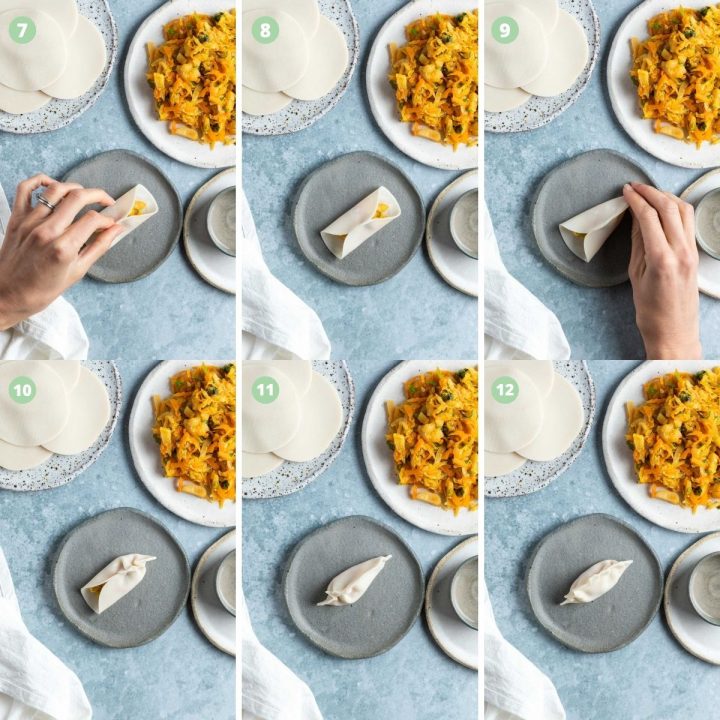

FAQ
Dumplings is the name given to a range of doughy treats. Gyoza are a specific Japanese dumpling.
Yes you can! Use leftover cooked vegetables, or cook any raw vegetables to remove the water and help prevent the dumplings from becoming soggy and falling apart.
Gyoza are traditionally served with a dipping sauce, often equal parts of soy sauce and vinegar, sometimes a little chilli oil (rayu) is added. They are eaten as the star rather than a side.
My recipe tips
- Once cooked, serve the gyoza immediately. The skins will become tough and very chewy if left.
- How to stop gyoza from sticking to the pan: if the cooked gyoza stick to the pan when you start to remove them, add a splash of boiling water to the pan (this should release them), and carefully remove with a spatula.
- For steam fried potstickers such as these – use hot water when adding it to the pan, as cold water will bring the temperature down.
Serving Ideas
- Serve them with a gyoza dipping sauce.
- As part of a Japanese style meal with silverbeet and spring rolls…
- Serve them in a simple miso broth (replacing the noodles with gyoza)
Gyoza Dipping Sauce
- Traditional – mix equal parts of soy sauce and vinegar, and a little chilli oil if you want some heat. I mix 2 tablespoons of soy sauce and 2 tablespoons of vinegar for the full amount of gyoza in this recipe.
- Horseradish – not traditional, but one of our favourites! Think of horseradish as an alternative to wasabi. Mix ½ teaspoon of creamed horseradish in to 2 tablespoons of soy sauce (or more horseradish if you like things fiery!).
Make ahead/storage
Gyoza Filling: you can make the miso veggie filling up to 3 days ahead and keep in the fridge until ready to use (I would add the fresh chives just before wrapping).
The gyoza are best either cooked straight after they are folded, or frozen.
To freeze: place in the freezer on the lightly floured plate or baking sheet. Once frozen, remove from the tray and place in a container or bag. Freeze for up to 2 months. Cook from frozen.
Why not try…
You may also like these other easy Japanese recipes:

Yasai Gyoza (Veggie Gyoza)
Author: Robyn
Ingredients
- 200g (7oz) wombok cabbage shredded
- 2 small carrots coarsely grated
- 2 spring onions finely sliced
- 2½cm (0.4 inches) fresh ginger finely grated (approx 1-1½ teaspoon grated ginger)
- 2 tablespoons neutral oil divided into 2
- 1½ tablespoons soy sauce
- ½ tablespoon white miso
- ½ tablespoon sesame oil plus extra to serve
- 100g (3.5oz) water chestnuts roughly chopped
- 2 tablespoons chives finely chopped
- 30 gyoza wrappers
- water for sealing the dumplings
- flour for dusting
- 120ml (½c) boiling water to cook the gyoza
- 1-2 teaspoons sesame seeds optional, for garnish
- fresh chives optional, for garnish
Instructions
- Fry the shredded cabbage, grated carrots, chopped spring onions and grated ginger in 1 tablespoon of oil over a medium heat until soft and all the water that the vegetables released whilst cooking has evaporated, around 4-5 minutes.
- Whisk the soy sauce, miso paste and sesame oil together.
- Pour this over the cooked vegetables and add the water chestnuts and cook for 2-3 minutes, stirring, until the liquid evaporates.
- Leave to cool.
- When cold, mix the chopped chives in to the vegetables.
- Lightly dust a plate or baking sheet with flour.
- Place a teaspoon of mixture in the centre of each gyoza wrapper, dip a clean finger into some water and use to paint the edges of each wrapper.
- Bring the edges together to form a moon shape and pleat to seal (for detailed photos on how to do this, please see in the post above.)
- After sealing a gyoza, place it on a floured tray, flat side down (the pleat should be at the top), repeat with the rest of the dumplings.
- If freezing, cover and freeze.
- When ready to cook the dumplings, heat a non stick frying pan over a medium to high heat and add one tablespoon of oil.
- Add the gyoza, flour side down, being careful not to overcrowd the pan – (the dumplings shouldn't be touching). You can cook them in two pans, or cook them in batches.
- Once golden, add 120ml (½c) boiling water from a kettle and cover with a well-fitting pan lid or a sheet of tin foil.
- Simmer for 4-5 minutes until they have absorbed all the water and are cooked.
- Turn the heat off, drizzle over a little sesame oil and using a spatula, carefully lift the dumplings out to a serving plate.
- Sprinkle with optional sesame seeds and finely chopped chives.
- Eat straight away.
- For dipping sauce to serve with the veggie gyoza, please see 2 recipes in the notes.
Notes
- Traditional – mix equal parts of soy sauce and vinegar, and a little chilli oil if you want some heat. I mix 2 tablespoons of soy sauce and 2 tablespoons of vinegar for the full amount of gyoza in this recipe.
- Horseradish – not traditional, but one of our favourites! Think of horseradish as an alternative to wasabi. Mix ½ teaspoon of creamed horseradish in to 2 tablespoons of soy sauce (or more horseradish if you like things fiery!).
Nutrition
HAVE YOU MADE THIS RECIPE?
I’d love to see your creation!
Or just leave a comment below!


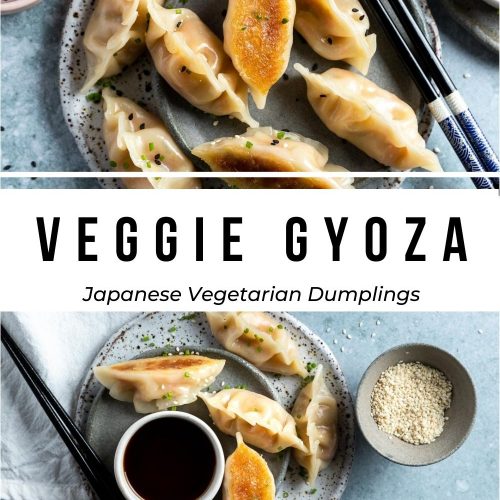

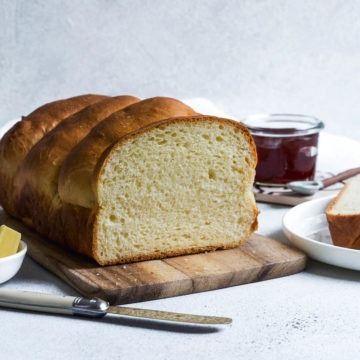
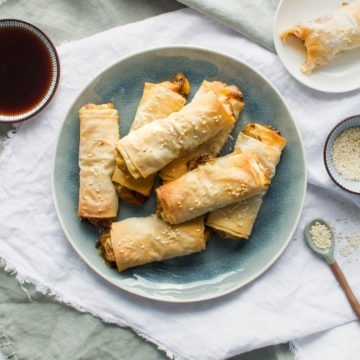

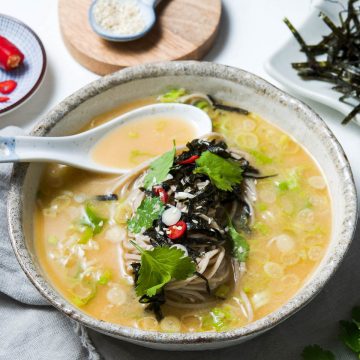
Let me know your thoughts!